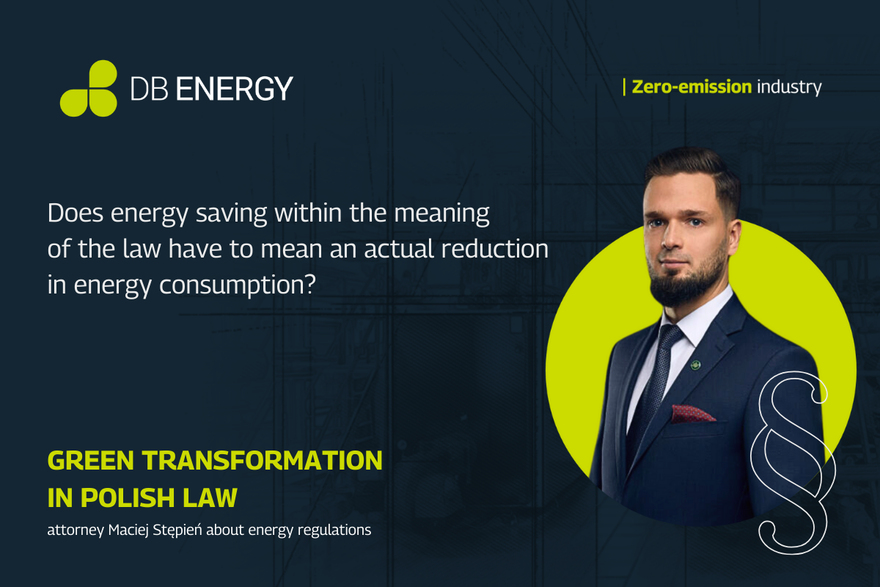Does energy saving within the meaning of the law have to mean an actual reduction in energy consumption?
Energy saving is one of the key goals of energy and climate policy, supported by the provisions of the Energy Efficiency Act. But does energy saving always have to mean a real reduction in the amount of energy used? The answer to this question is more complex than it seems. Entrepreneurs implementing energy-saving investments often encounter a narrow interpretation of the regulations, based on the linguistic meaning of the term saving.

Referring to the Dictionary of the Polish Language, the term saving is defined as "what has been saved, not used." Following this linguistic interpretation, one might conclude that energy saving refers to a tangible reduction in energy usage.
How is energy saving defined in EU law and Polish law?
The energy efficiency certificate system was introduced as part of the implementation of Directive 2012/27/EU of the European Parliament and of the Council of 25 October 2012 on energy efficiency. This directive amends Directives 2009/125/EC and 2010/30/EU and repeals Directives 2004/8/EC and 2006/32/EC. Article 2(5) of the directive defines energy savings as:
"The amount of energy saved, determined by measuring or estimating consumption before and after the implementation of a measure aimed at improving energy efficiency, while ensuring the standardisation of external conditions affecting energy consumption."
This definition highlights that energy savings can be calculated through measurements or estimates of energy consumption, before and after implementing a measure to improve energy efficiency, considering similar conditions.
In Polish law, Article 2(10) of the Energy Efficiency Act defines energy savings as:
"The amount of energy constituting the difference between the energy potentially consumed by a facility, technical device, or installation in a given period before the implementation of one or more projects aimed at improving energy efficiency, and the energy consumed by that facility, technical device, or installation in the same period after the implementation of those projects."
This statutory definition emphasizes that determining energy savings begins not with actual energy consumption before implementing efficiency measures, but with potential consumption. This must be demonstrated through an energy efficiency audit. The Polish legislator allows energy savings to be calculated both through measurement and estimation of energy consumption before and after implementing energy efficiency measures.
Savings and actual reduction in consumption
Although the common understanding of savings implies a reduction in consumption, neither EU law nor the Energy Efficiency Act requires an absolute reduction in energy usage to qualify as savings. The critical factor is that energy savings result from actions aimed at improving efficiency.
For example, consider a facility with a heating installation that was previously not used. After thermal modernization, including replacing energy sources with more efficient ones, heating begins. In such cases, energy savings must be calculated based on the conditions after modernization and a hypothetical assessment of what energy usage would have been without the investment.
The impact of the project on energy consumption is analyzed in terms of what would have occurred if the measures had not been implemented. This approach aims to incentivize the adoption of new technologies to improve energy efficiency during the preparation and execution of related investments.
Conclusions for practice
In practice, energy savings do not always mean physically using less energy. This perspective is reflected in most court rulings and energy law doctrine. As noted in the Commentary to the Energy Efficiency Act edited by Magdalena Porzeżyńska and Jan Sakławski:
"Energy savings are the amount of energy understood as the difference between the energy that could be estimated to be consumed by a given facility (technical device, installation) in a given time before the implementation of the project aimed at improving energy efficiency, and the energy actually consumed by this facility in the same period after the implementation of this project."
(Commentary to the Energy Efficiency Act, pages 11–12, C.H. BECK, 2021, ISBN: 9788382351613)
This concept can be simplified as follows:
[Energy potentially consumed before the implementation of measures] – [Energy actually consumed after the implementation of measures] = Energy savings.
To conclude, contrary to the intuitive understanding of savings, from a legal perspective, energy savings should be interpreted as the difference in energy consumption before and after modernization, emphasizing a hypothetical scenario without the investment.